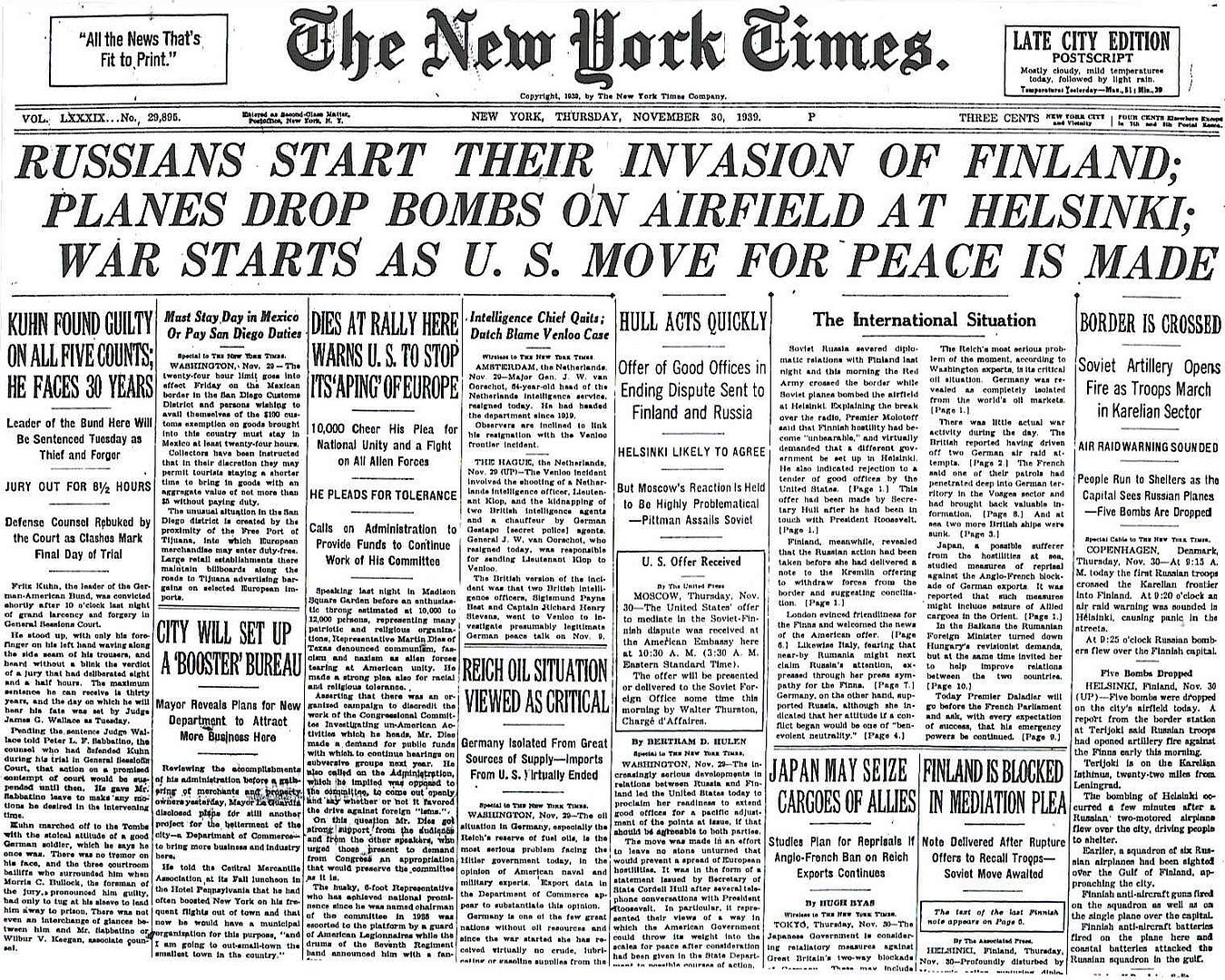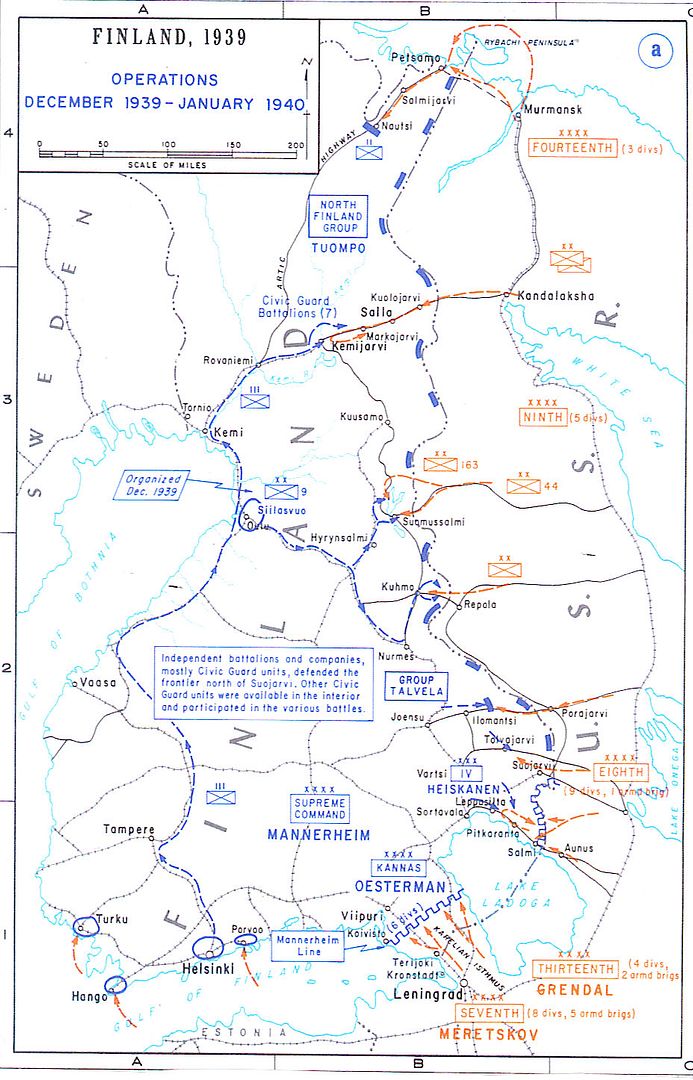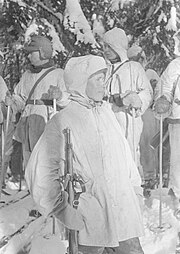
Posted on 11/30/2009 4:52:07 AM PST by Homer_J_Simpson

















Also posted on my profile.
William L. Shirer, The Rise and Fall of the Third Reich

Winston S. Churchill, The Gathering Storm


B.H. Liddell Hart, History of the Second World War
http://www.onwar.com/chrono/1939/nov39/f30nov39.htm
USSR invades Finland
Thursday, November 30, 1939 www.onwar.com
In Finland... The Winter War begins. Soviet forces invade Finland. Helsinki and Viipuri are bombed. The Finnish army can only muster about 150,000 men in 9 divisions, with a tenth being formed. There are also a number of smaller independent units but their reserves of manpower are small. They have little heavy equipment and virtually no tanks. They are handicapped here in having relied on their limited domestic arms production since late 1938 in their attempt to confirm their neutrality. There is an ammunition shortage. The air force has about 100 obsolete planes. These weaknesses are partly offset by the training and moral of the Finnish troops. There are also some fairly strong fortifications in this area but the system is by no means comprehensive. Field Marshal Mannerheim (aged 72) is appointed “Defender of Finland” and Commander-in-Chief. At the start of the invasion, the Soviets employ 26 divisions (not all at full strength), in four armies. Soviet divisions are larger, with artillery components three times as strong as their Finnish equivalents and accompanied by more tanks than the entire Finnish army possesses. Independent tank and artillery units provide additional support. The Soviet 7th Army, the strongest with 12 divisions, attacks the 5 Finnish divisions defending the Karelian Isthmus. The Soviet 8th Army advances in the area immediately north of Lake Ladoga, the Soviet 9th Army attacks from Soviet Karelia in the direction of the head of the Gulf of Bothnia and the Soviet 14th Army moves out from Murmansk in the far north. The strength of the Soviet forces is greater than expected by the Finns. However, the Soviets are not well prepared for winter conditions and the coordination between their infantry and other arms is not at all good. Their preparations have been rushed.
In Moscow... The Soviets announce that their action is in support of the Finnish People’s Government whose existence is now announced. This Soviet sponsored government is led by Otto Kuusinen, an exile, who has long been a member of the Comintern.
In Germany... Statistics indicate 120,000 persons are unemployed.
*Those two gentlemen in the photo look like best buds forever.
And the Finns kicked the crap out of the Rooskis too...
yes, but the price was enormous for a small country (30,000 dead, loss of eastern and arctic parts of the country to Soviet Union).
Soviets lost 130,000 man though. Happy for that.
Further proof that the Soviets bared much of the responsibility for the start of the war, right along with Germany.

Simo Häyhä--the Greatest Sniper
Simo Häyhä (190? - 2002) of Finland is regarded by many as the most effective sniper in the history of warfare. He was nicknamed "Belaya Smert" (White Death) by the Soviet troops he stalked in the forests of Finland during the four month long Winter War between those two countries in 1939-1940. Using a relatively primitive Russian made Mosin-Nagant Model 28 rifle with no scope, Häyhä sniped no less than 542 Soviet Union soldiers.
He was born in the small town of Rautjärvi in 1905 or 1906 (records conflict). In 1925 he joined the Finnish army for one year of mandatory service and left as a corporal with a bicycle unit. He joined the Civil Guard (much like the US National Guard) and drilled with his reserve unit until war broke out. On November 30, 1939 the Soviet Union, with a population of 171 million invaded tiny Finland whose population was only three million over territorial issues. This war brought Häyhä, now approaching middle age, to active service for the first time as a sniper assigned to Jaeger Regiment 34 along the Kolla River. Along some parts of this battlefront the Soviet Army outnumbered the defenders in ratios as high as 100:1.
Working in temperatures that almost never came above zero degrees and dressed completely in a white camouflage suit, the five foot tall Häyhä declined the use of a scoped Swedish Mauser rifle for the smaller Mosin carbine with iron sights. The Soviet leadership placed a price on his head and tried several ways to specifically get rid of him. Teams of Soviet snipers aided by artillery were deployed with the sole purpose of eliminating the tiny Finnish 'cuckoo'. Finnish snipers were called cuckoos by Russians, because they thought that all Finnish snipers were located in trees (and all trees contained snipers!). He was promoted to lieutenant personally by the Finnish commander Baron Field Marshal Mannerhiem. His 'confirmed kills' were listed at 542 with another two hundred unconfirmed. Most of his shots were taken while acting alone, shooting from a sitting position at ranges at or over 400 meters. Like most snipers he preferred to shoot officers and weapons crews.
On March 6, 1940, Häyhä was shot in the jaw while on the frontline and went into a coma. When he came out of his coma in the hospital nine days later Finland had lost the war. The town he was born in, Rautjärvi was lost to the Soviets in the peace settlement and remains part of that country (now Russia) to this day.
When interviewed by a group of American Mosin-Nagant collectors just before his death of old age in 2002 he was asked what his secret was to being such a good sniper he answered, "Practice."
iron sights. wow. kicking it old school style i guess.
must of been amazing stalker to always get to 400 meters or closer. i guess nowadays, its 1,000 meters with the barrett 50, or more.
still, sniping over 500 enemy, that is mind boggling.
Liked the small side article about forecasting Bessarabia as Stalin’s next target. Turned out to be 100% correct.
CBS - Elmer Davis on Soviet Invasion of Finland with analysis from Major George Fielding Elliot
CBS - Elmer Davis' general report on the Soviet Invasion of Finland
Marshal Mannerheim’s order of the day, November 30, 1939:
The President of the Republic has appointed me on 30.11.1939 as commander-in-chief of the armed forces of the country.
Brave soldiers of Finland!
I enter on this task at a time when our hereditary enemy is once again attacking our country. Confidence in one’s commander is the first condition for success.
You know me and I know you and know that everyone in the ranks is ready to do his duty even to death.
This war is nothing other than the continuation and final act of our War of Independence.
We are fighting for our homes, our faith and our country.
(cited by Stig Jägerskiöld in Mannerheim: Marshal of Finland, 1986, p. 111)
Marshal Mannerheim’s order of the day, November 30, 1939:
The President of the Republic has appointed me on 30.11.1939 as commander-in-chief of the armed forces of the country.
Brave soldiers of Finland!
I enter on this task at a time when our hereditary enemy is once again attacking our country. Confidence in one’s commander is the first condition for success.
You know me and I know you and know that everyone in the ranks is ready to do his duty even to death.
This war is nothing other than the continuation and final act of our War of Independence.
We are fighting for our homes, our faith and our country.
(cited by Stig Jagerskiold in Mannerheim: Marshal of Finland, 1986, p. 111)
Events of The Winter War-30 November, 1939:
Karelian Isthmus: the Soviet artillery opens fire at 6.50.
Soviet troops cross the border at several places without declaring war.Crossing points include Rajajoki, Joutselkä and Lipola.
Karelian Isthmus: the invading Soviet 7th Army has 120,000 men on the Isthmus with some 900 field guns and trench mortars and 1,400 tanks.The Finnish covering force on the Isthmus has 21,600 men, 71 field guns and 29 anti-tank guns.
Viipuri: first air-raid warning sounds at 9.00.
Ladoga Karelia: the Russians also have an overwhelming numerical superiority to the north of Lake Ladoga.The Finnish covering force joins battle along the entire length of the eastern border.
Soviet aircraft bomb 16 Finnish localities during the course of the day.
Helsinki: an air-raid warning sounds at 9.20.
Enso bombed at 9.35.
Viipuri: 13 enemy aircraft bomb the city for the second time at 10.00, leaving 10 dead and 11 injured.
Lahti: Lahti bombed at 12.05; five dead and one injured.
President Kyösti Kallio relinquishes his authority as Commander-in-Chief of the Armed Forces to Marshal Mannerheim and at 13.30 declares the country to be in a state of war.
Marshal Mannerheim accepts the responsibilities of Commander-in-Chief of the Armed Forces and issues his first Order of the Day.
Mannerheim in the Order of the Day: “We shall fight to protect our homes, our religion and our country.”
Seiskari: Soviet troops occupy the uninhabited island, where a red flag is sighted at 13.55.
Hanko: eight aircraft attack the town at 14.00.
Helsinki: the all-clear is given from the morning air-raid at 14.20.At 14.50, first six and then three more enemy aircraft appear out of the clouds and bomb the Hietalahti shipyard.91 people are killed and 236 injured, 36 seriously.
Eastern Isthmus: Group Rautu comes into contact with the enemy for the first time in the evening.
Rautu: intense fighting during the day at Palkeala. An enemy attempt to break through with the support of tanks is successfully repulsed.
Suojärvi: over a thousand civilians are trapped at the Hyrsylä bend and other border villages in the parish.
Smaller numbers of civilians have also been captured by the Russians on the islands in the Gulf of Finland, and at Salmi, Suomussalmi and Petsamo.
Parliament assembles at 20.00.The Government of Prime Minister A.K. Cajander presents its resignation.Parliament moves overnight to Kauhajoki.
Moscow radio broadcasts a speech during the night by Soviet Foreign Minister Vyacheslav Molotov.Molotov announces that the Soviet Government has ordered the Red Army to secure the external security of the Soviet Union.
Molotov renounces the Non-Aggression Treaty agreed with Finland in 1932.

I don't know - It looks to me like the Russians have as least as many roads available as the Finns do. What am I missing?
 Helsinki Civilians taking shelter from air raids, Molotov tells Soviet citizens on Moscow Radio that bombers are "dropping bread to the starving Finnish people" that they are "Rescuing".
Helsinki Civilians taking shelter from air raids, Molotov tells Soviet citizens on Moscow Radio that bombers are "dropping bread to the starving Finnish people" that they are "Rescuing".
Disclaimer: Opinions posted on Free Republic are those of the individual posters and do not necessarily represent the opinion of Free Republic or its management. All materials posted herein are protected by copyright law and the exemption for fair use of copyrighted works.